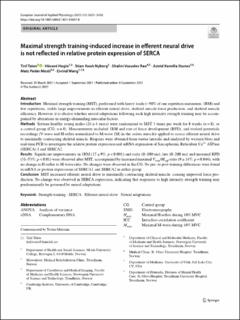| dc.contributor.author | Tøien, Tiril | |
| dc.contributor.author | Haglo, Håvard Pedersen | |
| dc.contributor.author | Nyberg, Stian Kwak | |
| dc.contributor.author | Rao, Shalini Vasudev | |
| dc.contributor.author | Stunes, Astrid Kamilla | |
| dc.contributor.author | Mosti, Mats Peder | |
| dc.contributor.author | Wang, Eivind | |
| dc.date.accessioned | 2024-01-22T11:46:27Z | |
| dc.date.available | 2024-01-22T11:46:27Z | |
| dc.date.created | 2021-09-15T12:21:49Z | |
| dc.date.issued | 2021 | |
| dc.identifier.citation | European Journal of Applied Physiology. 2021, 121 (12), 3421-3430. | en_US |
| dc.identifier.issn | 1439-6319 | |
| dc.identifier.uri | https://hdl.handle.net/11250/3113069 | |
| dc.description.abstract | Introduction Maximal strength training (MST), performed with heavy loads (~ 90% of one repetition maximum; 1RM) and few repetitions, yields large improvements in efferent neural drive, skeletal muscle force production, and skeletal muscle efficiency. However, it is elusive whether neural adaptations following such high intensity strength training may be accompanied by alterations in energy-demanding muscular factors. Methods Sixteen healthy young males (24 ± 4 years) were randomized to MST 3 times per week for 8 weeks (n = 8), or a control group (CG; n = 8). Measurements included 1RM and rate of force development (RFD), and evoked potentials recordings (V-wave and H-reflex normalized to M-wave (M) in the soleus muscle) applied to assess efferent neural drive to maximally contracting skeletal muscle. Biopsies were obtained from vastus lateralis and analyzed by western blots and real-time PCR to investigate the relative protein expression and mRNA expression of Sarcoplasmic Reticulum Ca2+ ATPase (SERCA) 1 and SERCA2. Results Significant improvements in 1RM (17 ± 9%; p < 0.001) and early (0–100 ms), late (0–200 ms) and maximal RFD (31–53%; p < 0.01) were observed after MST, accompanied by increased maximal Vmax/Msup-ratio (9 ± 14%; p = 0.046), with no change in H-reflex to M-wave ratio. No changes were observed in the CG. No pre- to post-training differences were found in mRNA or protein expressions of SERCA1 and SERCA2 in either group. Conclusion MST increased efferent neural drive to maximally contracting skeletal muscle, causing improved force production. No change was observed in SERCA expression, indicating that responses to high intensity strength training may predominantly be governed by neural adaptations. | en_US |
| dc.description.abstract | Maximal strength training-induced increase in efferent neural drive is not reflected in relative protein expression of SERCA | en_US |
| dc.language.iso | eng | en_US |
| dc.publisher | Elsevier | en_US |
| dc.relation.uri | https://doi.org/10.1007/s00421-021-04807-0 | |
| dc.rights | Navngivelse 4.0 Internasjonal | * |
| dc.rights.uri | http://creativecommons.org/licenses/by/4.0/deed.no | * |
| dc.title | Maximal strength training-induced increase in efferent neural drive is not reflected in relative protein expression of SERCA | en_US |
| dc.title.alternative | Maximal strength training-induced increase in efferent neural drive is not reflected in relative protein expression of SERCA | en_US |
| dc.type | Peer reviewed | en_US |
| dc.type | Journal article | en_US |
| dc.description.version | publishedVersion | en_US |
| dc.source.pagenumber | 3421-3430 | en_US |
| dc.source.volume | 121 | en_US |
| dc.source.journal | European Journal of Applied Physiology | en_US |
| dc.source.issue | 12 | en_US |
| dc.identifier.doi | 10.1007/s00421-021-04807-0 | |
| dc.identifier.cristin | 1934507 | |
| cristin.ispublished | true | |
| cristin.fulltext | original | |
| cristin.qualitycode | 1 | |

